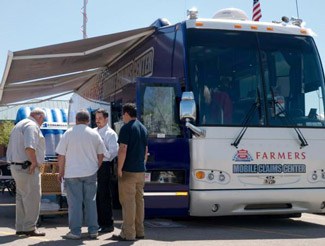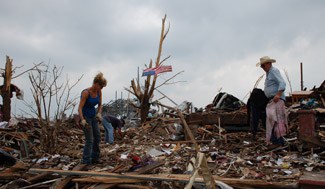How to file insurance claims after a natural disaster
The tornado that hit Joplin, Mo., in May 2011 was one of the worst in U.S. history, killing more than 140 people and wiping out nearly one-third of the city. Thousands of families were left homeless and lost all of their possessions. As of early June, about 17,000 tornado-spawned home and auto insurance claims had been filed in Joplin.
What happened in Joplin is an extreme situation, but natural disasters are by no means rare across the United States: Extreme weather caused more than $6 billion worth of damage in 2010. What with tornadoes, floods, ice storms, hurricanes and other types of extreme weather, many policyholders may need at some point to file a claim seeking compensation for damage to their cars and homes.
Here’s what to expect if it happens to you.
Assistance from a catastrophe team

Most large insurance companies work with mobile “catastrophe teams,” which can be set up in areas that have been devastated by natural disasters. Insurers typically set up booths where customers can file claims and discuss their cases. Eligible policyholders may receive “claim cards,” which can be activated immediately to cover payments for lodging, food, clothing and other necessities.
“We have a flexible staff, so we can ramp up our catastrophe resources when necessary, without disrupting our normal claims process,” says Tim Bowen, director of homeowner’s claims for MetLife.
In some cases, the claims process is speeded up. After his car sustained damage in a hailstorm, Rob Webster, a video producer from Kansas City, Mo., brought his vehicle to a catastrophe response center that his insurer had set up in a car lot. “They scheduled people in 15 minute shifts to get their cars inspected,” he says.
By the following day, the car was ruled a “total loss,” and Webster was given the option of getting a check for the pre-damage value or keeping his car, minus the “sell-back” value of a vehicle that’s sent to a junkyard. “I was pretty impressed with how quickly it all came together,” says Webster.
That’s not always the case, though.
“In my experience, the insurance companies are usually overwhelmed with the volume of the claims coming in,” says Kim Cary, senior general adjuster at Quality Claims Management in San Diego. “One person will often be handling 50 claims.”
Filing a claim
For people who’ve lost their homes to natural disasters, the claim-filing process can be difficult. They may have lost all of their important documents and may not remember their policy numbers. Nonetheless, it should be possible to file a claim.
“If a customer calls and doesn’t know his policy number, we’ll ask for details like the customer’s name, Social Security number and the city he was born in,” Bowen says. “If he doesn’t have a policy or any documentation, we’ll still begin the claims process. We’ll work carefully with the customer’s local agent to make sure that he is who he says he is if he doesn’t have any identification.”
However, if a customer needs to file a claim on a home that has a mortgage, Cary recommends that the customer call his mortgage broker. The broker should have a copy of the homeowner’s insurance policy on record; getting those details will simplify the filing process.
Hassles for homeowners
Unfortunately, there still may be challenges ahead, particularly for people who are filing claims related to home and personal property damage. When it comes to your possessions, the insurance company may need you to compile details on every item that needs to be replaced.
“They’ll often ask you to fill out a spreadsheet listing the name, age, and replacement cost of every item included in the claim,” Cary says.

If you haven’t kept careful records of all of your possessions, this may be difficult to do from memory. Insurers strongly recommend that you create a home inventory, either on paper or via one of several smartphone apps. Insurers suggest that your home inventory include video or photos of your belongings.
If your home has been destroyed and needs to be rebuilt, under-insurance could be an issue as well. “Particularly in large loss situations, the repair costs will go up because demand is so high and supply is so low,” Cary says. “After Hurricane Katrina, contractors were trucking in drywall from states away, which made costs skyrocket.”
If your insurance company refuses to cover the entire cost to rebuild, Cary recommends working with an independent adjuster, who may be able to get more money for your claim.
Fixing your home
When obtaining quotes for rebuilding costs, carefully research the vendors you’re considering. “Your insurance company may recommend preferred vendors, but you’re not required to use them,” Cary says.
Experts caution against going with a contractor who approaches you out of the blue.
“Contractors sometimes come in from out of the area to take advantage of the situation, and get people to advance or give them control over their insurance claims,” Bowen says. “They’ll do a hit-and-run while people are at their worst.”
To avoid potential problems, seek referrals from trusted friends for reputable contractors. “Get proper documentation for all work to be done, and carefully track any out-of-pocket expenses,” Bowen says.
Be prepared
Dealing with the loss of your home and possessions in the event of a natural disaster can be devastating, but a simple measure can lessen the damage: Keep important documents (including photo IDs, deeds, an inventory list of your valuable items and insurance policies) in a fireproof or waterproof safe, so that these documents are at the ready when you need to file claims.
Just as importantly, keep your prized family photos and heirlooms someplace out of harm’s way, such as in a safe. “We can replace your sofa and TV, but we can’t rebuild those memories,” Bowen says.